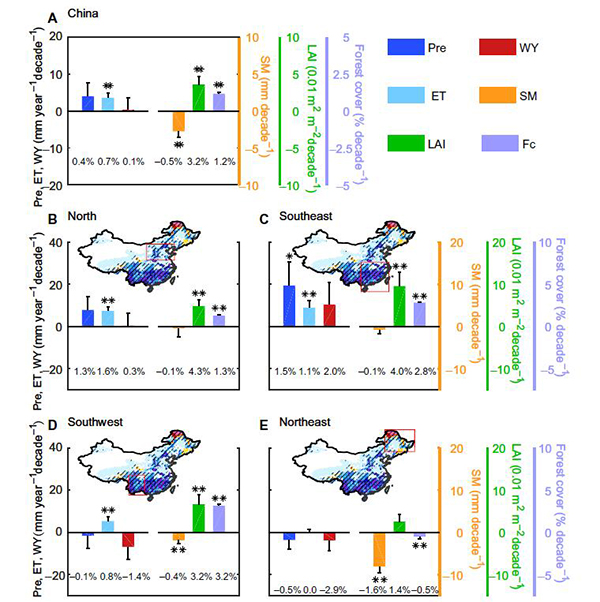Research
Divergent hydrological response to large-scale afforestation and vegetation greening in China
time:2018-05-17Citation:
Li, Y., Piao, S., Li, L. Z., Chen, A., Wang, X., Ciais, P., et al. (2018). Divergent hydrological response to large-scale afforestation and vegetation greening in China. Science Advances, 4(5), eaar4182.
Abstract:
China has experienced substantial changes in vegetation cover, with a 10% increase in the leaf area index and an ~41.5 million-hectare increase in forest area since the 1980s. Earlier studies have suggested that increases in leaf area and tree cover have led to a decline in soil moisture and runoff due to increased evapotranspiration (ET), especially in dry regions of China. However, those studies often ignored precipitation responses to vegetation increases, which could offset some of the negative impact on soil moisture by increased ET. We investigated 30-year vegetation impacts on regional hydrology by allowing for vegetation-induced changes in precipitation using a coupled land-atmosphere global climate model, with a higher spatial resolution zoomed grid over China. We found high spatial heterogeneity in the vegetation impacts on key hydrological variables across China. In North and Southeast China, the increased precipitation from vegetation greening and the increased forest area, although statistically insignificant, supplied enough water to cancel out enhanced ET, resulting in weak impact on soil moisture. In Southwest China, however, the increase in vegetation cover significantly reduced soil moisture while precipitation was suppressed by the weakened summer monsoon. In Northeast China, the only area where forest cover declined, soil moisture was significantly reduced, by −8.1 mm decade−1, likely because of an intensified anticyclonic circulation anomaly during summer. These results suggest that offline model simulations can overestimate the increase of soil dryness in response to afforestation in North China, if vegetation feedbacks lead to increased precipitation like in our study.

Figure. Linear trend of vegetation-induced changes (that is, SCE − CTL) in annual hydrological variables (including Pre, ET, Pre − ET, and total SM) and the trend in observed LAI and forest cover (Fc). (A) The whole country, (B) North China, (C) Southeast China, (D) Southwest China, and (E) Northeast China.
